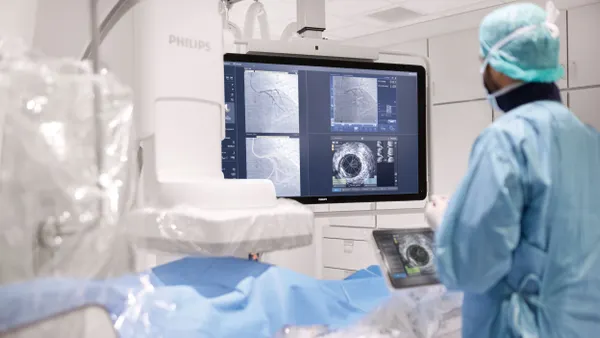Dive Brief:
- Edwards Lifesciences alerted customers it has received reports of cases in which difficulty manipulating its Centera transcatheter aortic valve replacement system resulted in vascular injury including aortic dissection and death.
- The urgent field safety notice, shared by various European regulatory bodies July 3, did not specify the number of deaths or injuries reported but said the incidence of serious events related to the issue is about 1.5%.
- The company said an investigation concluded that the tracking difficulty is more likely to occur in certain types of patient anatomies and recommended an alternate treatment for one situation and use of a stiffer guide wire in another.
Dive Insight:
Edwards’ Centera replacement valve received marketing authorization in Europe in February 2018 to treat high-risk patients with severe aortic stenosis. The device is not sold in the United States.
In October, the company announced it had started a 1,000-patient, single-arm U.S. pivotal trial of the Centera valve in aortic stenosis patients at intermediate risk of open heart surgery. Edwards also said it was resuming the commercial introduction of Centera in Europe after completing a previously announced minor modification to the device’s delivery system.
The Centera system would give Edwards a self-expanding valve in its lineup to compete directly with Medtronic’s CoreValve and Evolut TAVR systems, which are based on a self-expanding nitinol frame. Edwards’ Sapien valve, the first U.S.-approved transcatheter aortic valve, uses a balloon expandable delivery system.
The Centera valve is implanted using a motorized delivery system that allows a single operator to perform the procedure. CMS requires both an interventional cardiologist and cardiac surgeon to be present for a TAVR operation, but some physicians contend this is no longer necessary.
In its urgent field safety notice, Edwards said it received reports indicating some doctors performing the procedure were having difficulty manipulating the Centera valve around the aortic arch. For patients with extreme aortic tortuosity such as multiplanar curvature, Edwards recommended alternate treatment options like balloon expandable TAVR to avoid vascular injury. For patients with extremely dilated innominate trunks or acute angulation of the aortic arch, the company recommended use of a stiffer guide wire.
A CT angiography scan of the chest, abdomen and pelvis may be necessary to assess whether the aorta can accommodate the delivery system, the Edwards notice said. The company also recommended discontinuing use of the device and removing the system if resistance or difficulty is encountered while tracking around the aortic arch, or if it is kinked or damaged during use.
The field safety notice applies to all lots for model numbers 9551S23, 9551S26 and 9551S29, the notice said.











